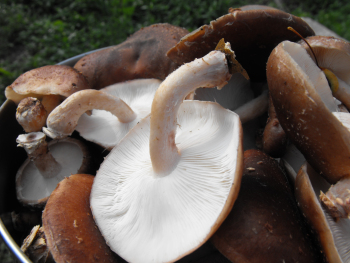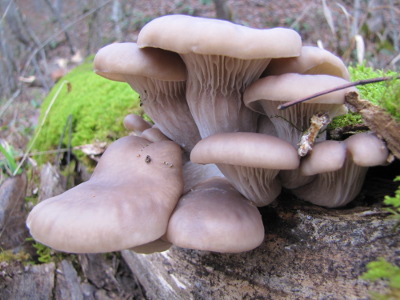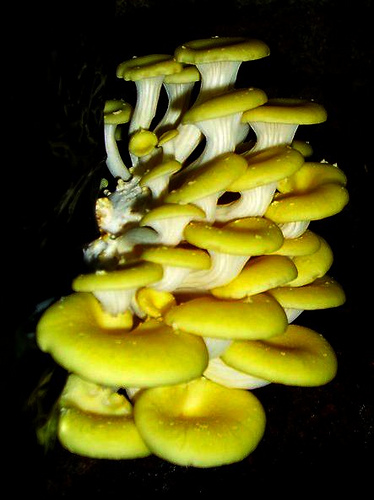
Best mushroom species to grow at home
 If
you're like I was when I got started in mushrooms, you don't even know
where to start. Which species is easiest, tastiest, and best for
backyard cultivation? There's no one right answer, but I'll give
you a rundown on the top seven species I've got my eye on or have tried.
If
you're like I was when I got started in mushrooms, you don't even know
where to start. Which species is easiest, tastiest, and best for
backyard cultivation? There's no one right answer, but I'll give
you a rundown on the top seven species I've got my eye on or have tried.
Shiitakes are the best known of
the mushroom species that can be grown in logs. We got our start
with shiitakes, and while I wouldn't discourage you from shiitakes if
you adore them, I've since changed my tune and fallen in love with
oyster mushrooms. After a bit of experience with both and then
some researching the topic, I've concluded that people like shiitakes
simply because they've heard of them, and that they've heard of them
because shiitakes have a longer shelf life than other wood-eating
mushrooms. I hesitate to say it, but maybe shiitakes are the red
delicious of the mushroom log world?
 Oyster mushrooms are our new
favorite. We bought some spawn two years ago on a whim, hoping to
extend our mushroom season into the spring and fall, and we quickly
fell in love with the taste, which we consider equal to or even better
than shiitakes. A nutritional analysis shows that oyster
mushrooms have two or three times as much protein as shiitakes and a
slightly more balanced set of amino acids, while containing the same
amount of vitamins and minerals. When it comes to cultivation,
the species is an even clearer winner --- oyster mushrooms can
be grown on "weed trees" rather than on hardwoods and the vigorous
spawn
will even colonize straw, coffee grounds, and other waste
products. You often see fruiting the first fall after you
inoculate oyster mushroom logs while you have to wait until the
following year to eat your first shiitake. And oysters are easy
to clone with low tech, home techniques. Plus, they're native, so
you can spread them through your woods with impunity. Are you
sold yet?
Oyster mushrooms are our new
favorite. We bought some spawn two years ago on a whim, hoping to
extend our mushroom season into the spring and fall, and we quickly
fell in love with the taste, which we consider equal to or even better
than shiitakes. A nutritional analysis shows that oyster
mushrooms have two or three times as much protein as shiitakes and a
slightly more balanced set of amino acids, while containing the same
amount of vitamins and minerals. When it comes to cultivation,
the species is an even clearer winner --- oyster mushrooms can
be grown on "weed trees" rather than on hardwoods and the vigorous
spawn
will even colonize straw, coffee grounds, and other waste
products. You often see fruiting the first fall after you
inoculate oyster mushroom logs while you have to wait until the
following year to eat your first shiitake. And oysters are easy
to clone with low tech, home techniques. Plus, they're native, so
you can spread them through your woods with impunity. Are you
sold yet?
 Maitake
would be a good choice if you live in a higher and drier location than
we do, where your woods is full of oaks. Around here, the maitake
is known as hen of the woods, but in Japan it is called the dancing
mushroom, presumably because you dance with joy when you find a twenty
pound hunk of edible fungus. I haven't tried to grow maitakes,
but I have been warned that they're a bit chancier to grow than oysters
or shiitakes.
Maitake
would be a good choice if you live in a higher and drier location than
we do, where your woods is full of oaks. Around here, the maitake
is known as hen of the woods, but in Japan it is called the dancing
mushroom, presumably because you dance with joy when you find a twenty
pound hunk of edible fungus. I haven't tried to grow maitakes,
but I have been warned that they're a bit chancier to grow than oysters
or shiitakes.
Elm
Oyster is not a
true oyster
mushroom with white mycelium; instead it has brown mycelium. This
distinction is important since brown rot fungi tend to work better when
grown in straw as a companion to vegetable plants. This mushroom
would
be a good choice to add to your vegetable garden, although I haven't
tried it yet, so can't vouch for its ease of cultivation.
King Stropharia is a good choice for
mycoremediation (more on that tomorrow.) I'm not sold on King
Stropharia yet since our first experiment with it was only minimally
successful, but if you've got a lot of free wood chips and a problem
area where coliform bacteria from your cows, pigs, or chickens is
running into a stream, you should definitely look into King Stropharia.

And now for some tougher
to grow mushrooms with tempting tastes:
Lion's
Mane is on our
list of
must-try mushrooms because it is reputed to taste like crabmeat or
lobster. The mushroom will grow on oak and maple.
Yellow
Oyster sounds a
bit like
a hothouse mushroom (literally and figuratively), but with a taste
described as resembling roasted almonds, I think we might have to give
it a shot. This tropical oyster mushroom won't grow outside,
though, so we'd have to provide it with a warm, moist environment.
As a final note, you
might be wondering why I didn't talk about the best-known mushrooms ---
portabellas and white button mushrooms (which are actually the same
species.) Although you can buy kits that will produce a few
flushes of these mushrooms (we tried it with so-so results), button
mushrooms have to grow on an aged and pasteurized mixture of horse
manure, chicken manure, and straw. Most backyard hobbiests will
have a hard time coming up with the right substrate, so you won't be
able to keep your spawn going once the kit peters out.
| This post is part of our Low Tech Mushroom Cultivation lunchtime
series.
Read all of the entries: |
Want more in-depth information? Browse through our books.
Or explore more posts by date or by subject.
About us: Anna Hess and Mark Hamilton spent over a decade living self-sufficiently in the mountains of Virginia before moving north to start over from scratch in the foothills of Ohio. They've experimented with permaculture, no-till gardening, trailersteading, home-based microbusinesses and much more, writing about their adventures in both blogs and books.
Want to be notified when new comments are posted on this page? Click on the RSS button after you add a comment to subscribe to the comment feed, or simply check the box beside "email replies to me" while writing your comment.
